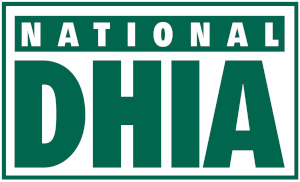1905

Helmer Rabild organized the first US DHI association in Michigan.
1936
USDA’s Bureau of Dairy Industry publishes Volume 1 of the DHIA Proved – Sire List
1952
DHIA recognized as important partner in the Cooperative State-Federal plan for eradication of Brucellosis from Grade A dairy herds.
1965
Established National Dairy Herd Improvement Association. National DHIA was started in six states, the primary purpose was to give dairy farmers participating in DHIA the opportunity to become partners in progress. Our founding leaders also wanted dairy producers to have a greater influence in determining policy and operating the DHIA System.
1966
First National DHIA Annual Meeting held in Greensboro, NC.
1978
First National DHIA Presidents’ Conference was held in St. Louis, MO. The purpose of the two day seminar was to inform presidents of state DHIAs of the objective of National DHIA and to gain input and suggestions from state DHIAs about the direction and future goals for ???
Executive Secretary position became full-time. National DHIA “lobbied” for research and extension funds in Washington and helped organize the Dairy Research Group and the Forum for Animal Agriculture. National DHIA office moved to Columbus, OH.
1980
“Many believe virtually all dairy farms will have on-farm computers by 1990.”
DHIA Presidents emphatically said National DHIA should spearhead rational development of on-farm computing systems. National DHIA established an On-Farm Computer Committee to develop policy for on-farm computers.
National DHIA begin studying the potential development of Quality Certification Services to assure the credibility and accuracy of records produced in the DHIA System.
1981
Magazine for DHIA Dairymen debuts.
1986
DHIA Services was established as a National DHIA subsidiary. The main objective was to provide products and services that support state DHIAs in boosting profitability to their members.
Council on Dairy Cattle Breeding (CDCB) established.
1988
DHIA Services entered into joint marketing venture with ProScience to develop the ProStaph I™ test for Staph. Aureus.
1989
DHIA Services developed a used equipment roster for members.
DHIA Services also began to offer a DHIA credit card designed to provide competitive benefits to members while offsetting testing fees.
Labor-Efficient Records (LER) approved as a new concept for
operating dairy record keeping programs with the goal of reduced
costs to members.
Top*Notch*Trainer (T*N*T), a new training program, was rolled out. This program was to assist state and regional DHIA organizations with their needs assessments, build training skills of DHIA employees, and encourage on-going commitment from National DHIA for the T*N*T program.
1990
National DHIA conducted a series of regional laboratory conferences (CA, NY, IA, and WI) to permit hands-on training
and intensive round table discussions on operation issues. This
type of support was a positive alternative to regulatory
approaches to quality improvement. The plan in future years was to
move toward measuring actual performance and not just quality training.
1992
Uniform data transfer among DRPCs, requested by DHIA management and farmers for over a decade, becomes a
reality due to the diligence of DRPC and National DHIA
leadership.
New Quality Certification manual prepared early in 1992 incorporated the input and advice of DHIA general managers and lab managers into the program. This QC manual and scorecard
continued the trend of stronger requirements and more stringent
goals for the DHIA field service and lab units to meet to be considered a certified member of National DHIA.
1993
Removal of state lines results in competition between DHIA Affiliates.
1994
Tulare DHIA and Lancaster DHIA become the first new DHIA Affiliates created in years.
1996
Record Standards variables were used for the first time to weight lactation records used in genetic evaluations.
Records Standards allowed producers to customize data collection protocols while keeping those records available to USDA-AIPL for use in genetic evaluations.
1998
American ID was implemented on January 1, 1998.
1999
Quality Certification Services (QCS) formed as a National DHIA subsidiary.
2000
January 1, 2000, the dairy records industry entered a new frontier.
For the first time, the quality certification standards were being
established by the Council on Dairy Cattle Breeding (CDCB) with input from the Field Service, Laboratory, and Processing Center Advisory Committees.
2002
The National DHIA Board of Directors’ structure was changed to include DHIA Managers as voting members.
2004
National Animal Identification System
(NAIS) started.
National DHIA entered into an ID pilot project with the PA Department of Ag to RFID tag 50,000 dairy animals and entered
them in PA HERDS, the state database. Working with Dairy One Cooperative, Lancaster DHIA and DRMS; the project was completed in a timely manner demonstrating that DHIA can be an effective partner in capturing needed data for NAIS.
National DHIA office moved to Wisconsin.
2008
National DHIA hosts the International Committee on Animal Recording (ICAR) biennial meeting in Niagara Falls. This meeting was attended by over 450 recording industry professionals
representing 43 countries.
DHIA Services launches www.EarTagCentral.com, an online store offering identification tags and equipment.
2010
QCS launches ELISA Proficiency Program for Johne’s testing of milk.
National DHIA simplifies Official Testing Plans to 20 options in order to meet the needs of today’s dairy operations.
2013
CDCB signs non-funded cooperative agreement with ARS.
2014
National DHIA Uniform Operating Procedures are revised and updated.
2015

National DHIA celebrates 50 years in business and develops a strategic vision plan for the future of the organization and the DHI industry.
2017
Jay Mattison, National DHIA CEO, elected President of International Committee on Animal Recording (ICAR).
2020
National DHIA Provided resolution supporting preferred animal ID to be electronic.
International Dairy Data Exchange Network (iDENN) established with seven international farmer-controlled stakeholders in an effort to provide a data hub to move data from the farm to data systems in each country.
2021
First virtual annual meeting held due to the COVID-19 pandemic.
